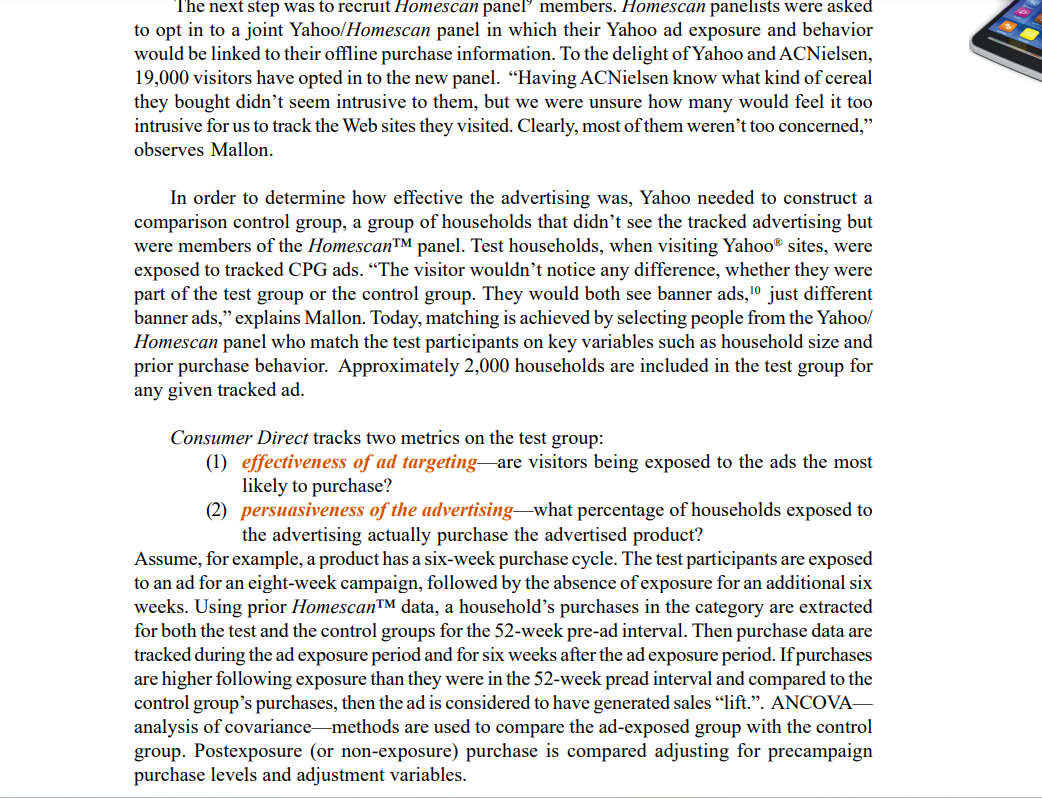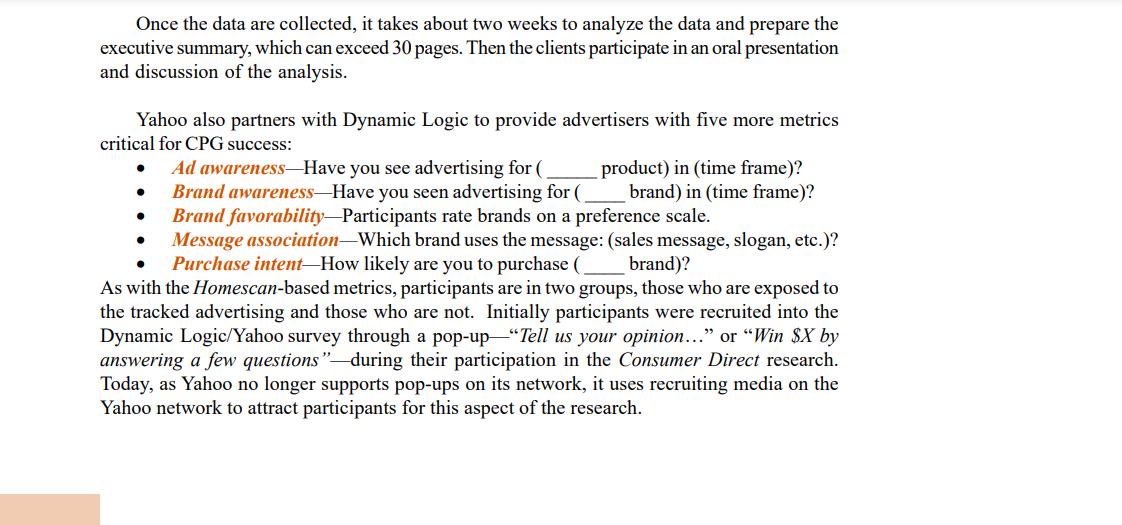Answered step by step
Verified Expert Solution
Question
1 Approved Answer
The next step was to recruit Homescan panel' members. Homescan panelists were asked to opt in to a joint Yahoo/Homescan panel in which their



The next step was to recruit Homescan panel' members. Homescan panelists were asked to opt in to a joint Yahoo/Homescan panel in which their Yahoo ad exposure and behavior would be linked to their offline purchase information. To the delight of Yahoo and ACNielsen, 19,000 visitors have opted in to the new panel. "Having ACNielsen know what kind of cereal they bought didn't seem intrusive to them, but we were unsure how many would feel it too intrusive for us to track the Web sites they visited. Clearly, most of them weren't too concerned," observes Mallon. In order to determine how effective the advertising was, Yahoo needed to construct a comparison control group, a group of households that didn't see the tracked advertising but were members of the Homescan panel. Test households, when visiting Yahoo sites, were exposed to tracked CPG ads. "The visitor wouldn't notice any difference, whether they were part of the test group or the control group. They would both see banner ads, 10 just different banner ads," explains Mallon. Today, matching is achieved by selecting people from the Yahoo/ Homescan panel who match the test participants on key variables such as household size and prior purchase behavior. Approximately 2,000 households are included in the test group for any given tracked ad. Consumer Direct tracks two metrics on the test group: ectiveness of ad targeting-are visitors being exposed to the ads the most likely to purchase? (2) persuasiveness of the advertising-what percentage of households exposed to the advertising actually purchase the advertised product? Assume, for example, a product has a six-week purchase cycle. The test participants are exposed to an ad for an eight-week campaign, followed by the absence of exposure for an additional six weeks. Using prior HomescanTM data, a household's purchases in the category are extracted for both the test and the control groups for the 52-week pre-ad interval. Then purchase data are tracked during the ad exposure period and for six weeks after the ad exposure period. If purchases are higher following exposure than they were in the 52-week pread interval and compared to the control group's purchases, then the ad is considered to have generated sales "lift.". ANCOVA- analysis of covariance methods are used to compare the ad-exposed group with the control group. Postexposure (or non-exposure) purchase is compared adjusting for precampaign purchase levels and adjustment variables. Once the data are collected, it takes about two weeks to analyze the data and prepare the executive summary, which can exceed 30 pages. Then the clients participate in an oral presentation and discussion of the analysis. Yahoo also partners with Dynamic Logic to provide advertisers with five more metrics critical for CPG success: Ad awareness-Have you see advertising for ( Brand awareness-Have you seen advertising for ( Brand favorability-Participants rate brands on a preference scale. Message association-Which brand uses the message: (sales message, slogan, etc.)? Purchase intent-How likely are you to purchase ( brand)? As with the Homescan-based metrics, participants are in two groups, those who are exposed to the tracked advertising and those who are not. Initially participants were recruited into the Dynamic Logic/Yahoo survey through a pop-up "Tell us your opinion..." or "Win $X by answering a few questions" during their participation in the Consumer Direct research. Today, as Yahoo no longer supports pop-ups on its network, it uses recruiting media on the Yahoo network to attract participants for this aspect of the research. product) in (time frame)? brand) in (time frame)? >Discussion >Using the Research Ultimately the goal of Consumer Direct is more efficient and effective Internet advertising. "Yahoo wants to help its advertising clients more effectively target ad content to those more likely to purchase. Using the browsing patterns of high-purchase households in the Consumer Direct research to model behavior, we then apply this knowledge to the Yahoo database to identify 10 million households that exhibit similar browsing behavior," explains Mallon." Whether a low-penetration product has moved from 2 percent to 7 percent of households purchasing or a high-penetration product (purchased by more than 75 percent of households) experienced a purchase increases of 5 percent, every single Consumer Direct client has experienced sales lift. Clearly Yahoo is collecting the information it needs to help its clients get effective use from their Internet advertising. 123456 2 Yahoo Consumer Direct Marries Purchase Metrics to Banner Ads 6 Describe the research design for Consumer Direct. Discuss the strengths and weaknesses of the research design. How has the use of panels affected the research design? How have ethical issues influenced the research design? Define the various measurements collected in Consumer Direct. What analysis would be appropriate for the data collected through Consumer Direct?
Step by Step Solution
★★★★★
3.46 Rating (166 Votes )
There are 3 Steps involved in it
Step: 1
1 Describe the research design for Consumer Direct Consumer Direct utilizes a quasiexperimental research design with a combination of test and control groups Yahoo recruits Homescan panel members who ...
Get Instant Access to Expert-Tailored Solutions
See step-by-step solutions with expert insights and AI powered tools for academic success
Step: 2

Step: 3

Ace Your Homework with AI
Get the answers you need in no time with our AI-driven, step-by-step assistance
Get Started


